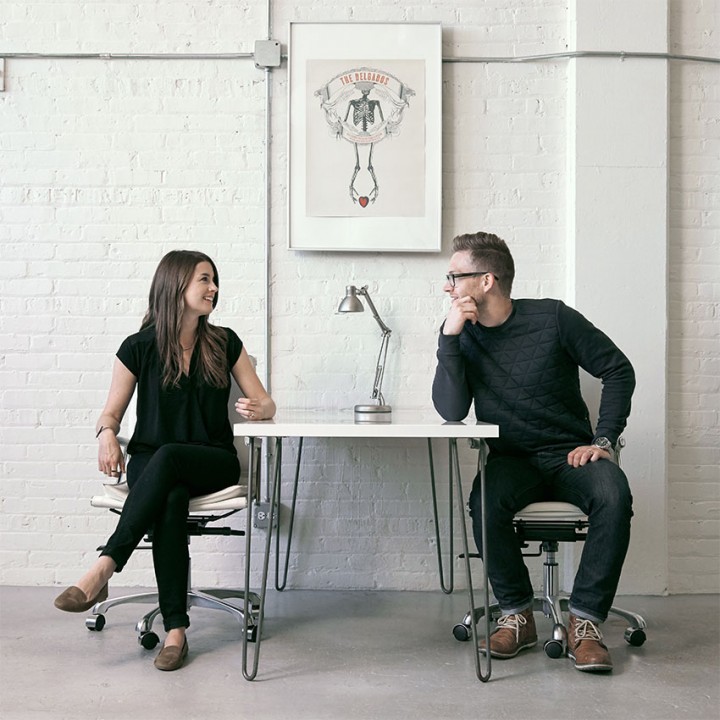5 Ways to Attract Your Own Clients


Once in a while we get asked how we were able to get away from agency work and attract small business and startup clients of our own. It’s a great question! And one that deserves a thoughtful answer since there are a few factors involved. These are the things that worked for us. You do you. But maybe there’s something in this pile of thoughts that will help you get to where you want to be:
1. Change your game
Before we started Knoed, Kyle and I worked at other companies for 6 years. At the start of our 7th year, we both left our jobs to freelance full-time in hopes of gaining our own direct clients. We let all of our contacts know we were available for projects, which was mostly agencies around town because that’s who we knew. We started out working as subcontractors for a few of them, but we had a rule that we never worked on-site nor did weekly or monthly contracts with them—only project-based work. Why? Because we both wanted to eventually have our own clients and we knew if we worked on-site for agencies or did time-based contracts, we would get sucked back into that world and never get the time needed to build our own client list.
Even with those rules in place, 80% of our work was working on projects for agencies and 20% was for our own clients. How did we get that 20%? Slowly over time through word of mouth and our individual websites.
We started out marketing ourselves as Independent Designers, but we couldn’t seem to get the phone to ring from small businesses as often as we wanted. During the year we freelanced, we would sometimes help each other out or brainstorm ideas together for our projects. It didn’t take long before we realized we made a great team.
After many discussions, we decided to join forces—create a company, pitch new work together, collaborate on projects together and combine our portfolios. It was a big step! But we were committed. We thought up names, decided on Knoed Creative, created a website and combined our portfolios.
On 1.11.11 we launched the site. Starting Knoed immediately altered how we were being perceived. We were now a company of two instead of two freelancers.
What we didn’t anticipate was a complete 180º with who we attracted. Even though we were the same people, with the same experience and same portfolio, we were now being seen in a whole new light. Small businesses began knocking on our door and the agencies nearly disappeared. We learned that being a company of two people instead of one made the difference.
We didn’t know this at the time, but we learned that small businesses can be leery of freelancers or solopreneurs because there’s a perception that they’re unstable, in between jobs or not serious about their careers. Some small businesses hire freelancers because they don’t want to spend a lot of money, and many freelancers fit their budgets. On the other hand, agencies love freelancers because they need people who can float around and take on odd jobs when things get too busy. But when you’re a company, you immediately gain more respect, more trust and more attention from small businesses. They feel more confident in your abilities and that you’re not going anywhere.
Within the first year of starting Knoed, our stats flipped and 80% of our work was with our own clients and 20% was with agencies. By the second year, our work was (and still is) 100% with our own clients.
We’re not suggesting that every freelancer should start a company with others. But this was a game-changer for us. If what you’re currently doing isn’t working, try taking a different approach. Instead of going by your name, create a company name. But in our opinion, it’s important to be honest and transparent if it’s just you. If you say ‘we’ when it’s just you, then you’re creating an illusion that the client will see through on the first call with you, and doubt will set in with them. Trust is in a fragile state with new relationships and you don’t want to lose it before you get the chance to prove yourself.
2. Find your niche and your “why”
As graphic designers, we’re used to focusing on design and making our work as good as possible to stand out. But when it comes to building your business, you have to put your business hat on before you get to the design.
Your website is your best marketing tool for people to find you or look you up. Consider who you’re targeting and what you’re saying. There’s a ton of freelancers, design firms and agencies out there all doing the same exact thing as you. What makes you different? Why are you in business? (Speaking of why, watch Simon Sinek’s TED talk to get you inspired on this very topic.) Know what type of clients or industries you’d like to attract so you can create a much more targeted strategy and know where to look for new business. Finding a niche can help build your name quickly and, hopefully, lead to more work.
We love doing business strategy, creating visual identities, positioning, designing websites, printed collateral, copywriting and even packaging. We found that the best way to get our hands on all that stuff is to start at the beginning. We chose to focus on branding because we really enjoy designing companies from the ground up and we love working with people who are starting/building/creating things that we can get behind. We only show that type of work in our portfolio and we speak to that throughout our website to attract those types of clients and projects. Everything we say and everything we show is intentional, focused and follows our strategy.
Something that sets us apart is that we’re two people. We embrace being small and use it as our differentiator and selling point. We’re bigger than a freelancer and smaller than a design firm. What you see in our portfolio is what you get—there’s no revolving door with designers coming in and out. When you call, we’re the ones answering the phone and working on the project so there’s never communication lost in translation. We give extremely personalized service and are so involved in the making of their company that our clients often become friends. And being just two people, it doesn’t take much to keep us busy, so we’re very selective about what and how much we work on to make sure every project gets the attention it deserves. This is our strategy and our differentiator, and none of it is made up just to sound good. It’s what we believe and it’s our why.
3. Think like a marketing person
Take a look at the the type of projects you’re showing in your portfolio. Is it the kind of work you want to be getting? Does it relate to the type of clients you hope to attract?
If your portfolio is a showcase of work for big box stores or Fortune 100 companies and you want to be working with small businesses, startups and mom-n-pop shops, then there’s a disconnect happening. You should be showing the type of work you want to attract and work that represents the type of clients you hope to get.
What people see is what they want. If a small business owner comes to your site, they want to see that you work on projects of a similar scope and for a similar clientele. If all they see is big brands you did at your old job, they might not be able to picture what you would do for them or they might think that they’re not ‘big enough’ to work with you.
If you don’t have any examples to show that relate to the type of work/clients you want to get, then it’s time to start working on some. You can take any business that exists and redesign everything from the ground up. It doesn’t have to be a produced project—it can be conceptual. What’s great about this is, it’s all up to you! You don’t have to get approvals from the client—it’s purely your vision. What matters is that you’re doing work that’s representative of what you hope to get.
If it’s important to you that it gets produced, then do some pro bono work for a company who could use a redesign—get them on board and involved from the start and let them be your guinea pig so you can start building the kind of portfolio you want. There are so many businesses who need help with design. Just make sure you find the right fit so that what you work on is what you want to be working on. Especially if you’re doing it for free.
4. Hone your people skills
This one seems like common sense, but there are a lot of people who lose projects or clients because of this. When you do start getting the type of clients and projects you want, treat them like gold. Sometimes we designers are great at being creative, but not the best at being organized or giving great customer service.
For example, put time into the way you email. Be friendly. Be positive. Make jokes (when appropriate). Be responsive. Never wait more than 24 hours to respond to an email. Even if it’s a reply verifying that you received their email and will get back to them as soon as possible. Be thorough and organized. Part of your job is to take care of stuff they don’t have the time to take care of.
It all matters when you’re in business for yourself, and clients care about all of it. If you treat them well, keep them in the loop, stay on schedule and deliver great work, you’re golden. That will lead to more projects with them, and they’ll tell everyone they know about you.
5. Evaluate, re-evaluate and repeat
Working on the business side of design is a process, and one that is constantly evolving. We’re always thinking about our business and trying to improve our own processes. It’s necessary that you spend time thinking about how you can improve where you need to, come up with ways to solve these problems and implement those strategies one at a time. Use tools that will help you streamline your process and give the best client experience. At Knoed, we use the following apps to make our lives easier and give the best experience for our clients:
- Harvest for time tracking, estimates and invoicing
- Basecamp for project management and scheduling
- Our own Job Book for managing our finances
- Quickbooks for bookkeeping
- InVision and LiveView for web and mobile prototyping
- Slack for communication channels internally and externally
- Dropbox for sending files
- Google Hangouts for online meetings
- Zoom for video conferencing
- Intuit for payroll
- Backblaze as a second backup to our external hard drives
If you do start incorporating some of these ideas into your business, have patience and be aware of any small changes that start to take effect. If things start heading in the right direction, then the changes you made are working. If not, try a different approach. This is what we’ve found works for us. If you have any tips or recommendations of your own, let us know in the comments below!
Written by Kim Knoll, Partner and Creative Director at Knoed Creative in Chicago.
Subscribe to our mailing list or follow us on Instagram, Twitter or Facebook.
Related articles:
Advice To Young Designers by Knoed Creative
Start With Why by Simon Sinek
How To Become Exceptional At Your Craft by Ira Glass